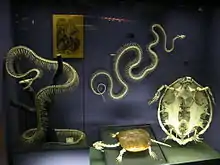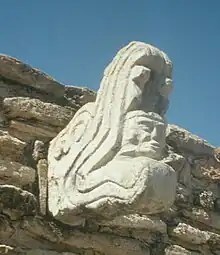Portal:Snakes
The Snake Portal Snakes are elongated, limbless, carnivorous reptiles of the suborder Serpentes (/sɜːrˈpɛntiːz/). Like all other squamates, snakes are ectothermic, amniote vertebrates covered in overlapping scales. Many species of snakes have skulls with several more joints than their lizard ancestors, enabling them to swallow prey much larger than their heads (cranial kinesis). To accommodate their narrow bodies, snakes' paired organs (such as kidneys) appear one in front of the other instead of side by side, and most have only one functional lung. Some species retain a pelvic girdle with a pair of vestigial claws on either side of the cloaca. Lizards have independently evolved elongate bodies without limbs or with greatly reduced limbs at least twenty-five times via convergent evolution, leading to many lineages of legless lizards. These resemble snakes, but several common groups of legless lizards have eyelids and external ears, which snakes lack, although this rule is not universal (see Amphisbaenia, Dibamidae, and Pygopodidae). Living snakes are found on every continent except Antarctica, and on most smaller land masses; exceptions include some large islands, such as Ireland, Iceland, Greenland, the Hawaiian archipelago, and the islands of New Zealand, as well as many small islands of the Atlantic and central Pacific oceans. Additionally, sea snakes are widespread throughout the Indian and Pacific oceans. Around thirty families are currently recognized, comprising about 520 genera and about 3,900 species. They range in size from the tiny, 10.4 cm-long (4.1 in) Barbados threadsnake to the reticulated python of 6.95 meters (22.8 ft) in length. The fossil species Titanoboa cerrejonensis was 12.8 meters (42 ft) long. Snakes are thought to have evolved from either burrowing or aquatic lizards, perhaps during the Jurassic period, with the earliest known fossils dating to between 143 and 167 Ma ago. The diversity of modern snakes appeared during the Paleocene epoch (c. 66 to 56 Ma ago, after the Cretaceous–Paleogene extinction event). The oldest preserved descriptions of snakes can be found in the Brooklyn Papyrus. (Full article...) Selected article -A snakebite is an injury caused by the bite of a snake, especially a venomous snake. A common sign of a bite from a venomous snake is the presence of two puncture wounds from the animal's fangs. Sometimes venom injection from the bite may occur. This may result in redness, swelling, and severe pain at the area, which may take up to an hour to appear. Vomiting, blurred vision, tingling of the limbs, and sweating may result. Most bites are on the hands, arms, or legs. Fear following a bite is common with symptoms of a racing heart and feeling faint. The venom may cause bleeding, kidney failure, a severe allergic reaction, tissue death around the bite, or breathing problems. Bites may result in the loss of a limb or other chronic problems or even death. The outcome depends on the type of snake, the area of the body bitten, the amount of snake venom injected, the general health of the person bitten and whether or not anti-venom serum has been administered by a doctor in a timely manner. Problems are often more severe in children than adults, due to their smaller size. Allergic reactions to snake venom can further complicate outcomes and can include anaphylaxis, requiring additional treatment and in some cases resulting in death. (Full article...)Did you know (auto-generated) -
More did you know? - A snake
Quality ContentFeatured snake-related articles - George Went Hensley - List of snakes of Trinidad and Tobago Good snake-related articles - Agkistrodon piscivorus - Bitis arietans - Bitis gabonica - Black mamba - Black-necked spitting cobra - Eastern green mamba - Forest cobra - Hydrophiinae - Many-banded krait - Nerodia clarkii - Russell's viper - Snake scales - Vipera berus - Western green mamba General imagesThe following are images from various snake-related articles on Wikipedia.
Selected image
TopicsLists - List of snakes by common name - List of Serpentes families - List of snake genera - List of dangerous snakes
Families - Acrochordidae - Aniliidae - Anomochilidae - Boidae - Bolyeriidae - Colubridae - Cylindrophiidae - Elapidae - Loxocemidae - Pythonidae - Tropidophiidae - Uropeltidae - Viperidae - Xenopeltidae - Anomalepididae - Leptotyphlopidae - Typhlopidae Anatomy and physiology - Infrared sensing in snakes - Pelvic spur - Snake scales - Snake skeleton SubcategoriesCategory puzzle Select [►] to view subcategories
Snakes Snakes by location Snake common names Lists of snakes Alethinophidia Snake genera Prehistoric snakes Scolecophidia Set index articles on snakes Snake anatomy Snake families Snakes and humans Venomous snakes Snake stubs Related portalsNeed help?Do you have a question about Snakes that you can't find the answer to? Consider asking it at the Wikipedia reference desk. Snakes in the newsNo recent news Things you can do
Help at WikiProjects:
Associated WikimediaThe following Wikimedia Foundation sister projects provide more on this subject:
Discover Wikipedia using portals
|












_%E9%89%A4%E7%9B%B2%E8%9B%871.jpg.webp)






.svg.png.webp)



















.jpg.webp)




